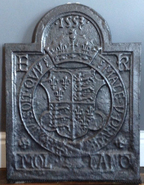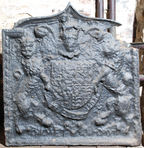-
995
Description: Arched; fillet edging; English royal Stuart shield, garter, crown, supporters, 'CS' monogram to left of Garter buckle, and motto on a cartouche; small rose stamp repeated each side of crown; date split each side of top of crown (first part absent in this casting).
Notes: Although English arms, the design is in a continental style, arched firebacks being typical of Lorraine; the 'CS' monogram is likely to be that of the pattern-maker; a modern copy of a poor casting, hence the incomplete date. For the complete version see no. 994. Inferior copies of this fireback were advertised in Kings Worthy Foundry's (Winchester) catalogue in the mid-20th century.
Copies of this fireback are known.
Inscription: [16 missing] 21 / HONI SOIT QVI MAL Y PENSE / CS / DIEV ET MON DROIT
Arms: English Stuart royal (James I)
- Decoration tags:
- rounded arched (shape)
- cavetto (edging)
- whole carved pattern
- planklines
- monogram
- armorial
- royal
- text
Manufactured: in 1621 in England.
Current location: not known.
- Attached to series:
- Jacobean royal armorial firebacks
- Stuart royal armorial firebacks
-
850
Description: Canted rectangle; elaborate cavetto moulded edging (top and sides); strapwork shield with a demi-flower at each side, between initials (S only visible); arms quarterly of six, 1st Or two chevronels Gules, on a canton of the last a mullet of the first (Pope); 2nd Argent three bars Gules, on a canton ermine a bend of lozenges of the second (Walshe); 3rd Sable three laurel leaves in bend Or between two bendlets Argent (Waller); 4th Azure a chevron between three crosses Moline Argent (Lansdale); 5th Ermine on a bend Gules three lions’ heads erased Or (Weston); 6th Azure a lion rampant Or supporting a cross patée fitchée of the second (Pichingham).
Notes: The excrescence over the third quartering is the result of the iron being poured directly onto the mould. The second initial is known from another casting. The date above the shield has been inserted before casting and differs slightly from another example of the same back.
Copies of this fireback are known.
Inscription: 1625 / S [P]
Arms: Pope (Sackevile Pope (b. 1589) of Hendall, in Buxted, Sussex)
- Decoration tags:
- rectangular with canted top corners (shape)
- complex individual (edging)
- whole carved pattern
- date stamp
- armorial
- text
Manufactured: in 1625 in the Weald area of England.
Current location: not known.
- Attached to series:
- Personal armorial firebacks
- Low relief armorial series
-
1323
Description: Arched rectangular with broad fillet edges; arched rectangular inset with cavetto edging and armorial design in low relief: circular garter enclosing an ornate Tudor royal shield, surmounted by a crown; date inside top of arch; initials inside top corners of rectangle; a rose in each bottom corner of rectangle; inscription in a separate rectangular panel below, split by garter buckle.
Notes: An altered commercial copy of a Tudor fireback (no. 288) produced by F. Parkin & Sons (Exeter) and advertised in their 1972 catalogue. The width of the edges of the original fireback has been narrowed possibly to reduce weight and cost or for aesthetic reasons.
Copies of this fireback are known.
Inscription: 1553 / E R / HONV SOIT QVY MALE V PENCE / MOL LAND
Arms: Tudor royal - Edward VI
- Decoration tags:
- rectangular with round arch (shape)
- fillet (edging)
- whole carved pattern
- armorial
- royal
- text
Manufactured: in 1972 at Bonhay Foundry, Exeter in England.
Current location: not known.
- Attached to series:
- Edwardian royal armorial firebacks
-
74
Description: Rectangle with flattened ogee arch; ovolo, simulated rope edging; shield, garter, helm, mantling, crown and supporters (crowned lion and unicorn) of the English royal house of Stuart; motto across base
Notes: A variation of a type, dated 1618, noted at Burwash, Sussex.
Copies of this fireback are known.
Inscription: DIEU ET MON DROIT
Arms: English Stuart royal
- Decoration tags:
- rectangular with ogee-arch (shape)
- simulated rope (edging)
- whole carved pattern
- armorial
- text
Manufactured: in the early-17th century possibly in the Weald area of England.
Current location: in private hands, Groombridge, Kent, England.
- Attached to series:
- Stuart royal armorial firebacks
- Bristol armorial group
-
357
Description: Stove side plate; ovolo moulded edging; upper panel, pictorial scene of Jesus and the woman of Samaria (John: 4), with inscription below; lower panel, two circular frames, each with a figure, male to the right, female to the left, decorative scroll work between.
Notes: Stove plates were often used as firebacks once the stoves had been replaced by more efficient ones.
Inscription: VON DEN FREWLEIN VON SAMARIA IOHAN 4
- Decoration tags:
- rectangular (shape)
- flanged (edging)
- whole carved pattern
- planklines
- pictorial
- biblical
- architectural
- text
- humans
- objects
Manufactured: in the late-16th to early-17th century in the Eifel area of Germany.
Current location: Baddesley Clinton Hall, Knowle, Warwickshire, England.
(part of the National Trust museum group)
- Attached to series:
- Stoveplates
- Woman of Samaria stoveplates
-
381
Description: Fragment; left part of rectangle; twisted rope border (top and sides); long, narrow stamp with undulating vine motif, repeated three times in 'A' shape with top bar; short length of same strip repeated six times, one across middle of 'A', two each side of 'A' at top, one lower right; indistinct stamp with swirled floral design between lower legs of 'A'.
Notes: The same vine strip stamp is seen, in both long and short lengths, on many firebacks, indicating a common source. All the stamps were probably derived from redundant furniture.
- Decoration tags:
- rectangular (shape)
- rope (edging)
- simple stamps
- objects
Manufactured: in the mid- to late-16th century possibly at Pounsley Furnace, Framfield in the Weald area of England.
Current location: Anne of Cleves House, Southover High Street, Lewes, East Sussex, England.
Museum number: LH000.913 (part of the Sussex Archaeological Society museum group)
- Attached to series:
- Pounsley series
- Vine strip series
- Furniture stamp firebacks
-
1189
Description: Arched rectangular shape; cavetto-moulded edging; central, two handled, gadrooned vase with swirled, fruited vines issuing from the neck, and a bird on each side perched within the vines; out of the neck, a naïve human figure with arms outstretched, grasping vines on each side.
Notes: The figure emerging from the vase has a symbolism which has yet to be explained; more than one version of this fireback exists. Mallams auction, Abingdon, 28 Jun 2023, lot 219 (£60). Copies of this fireback were advertised in Kings Worthy Foundry's (Winchester) catalogue in the mid-20th century.
Copies of this fireback are known.
- Decoration tags:
- rectangular with round arch (shape)
- cavetto (edging)
- whole carved pattern
- animals
- humans
- plants
- objects
Manufactured: in the mid-17th century in the Weald area of England.
Current location: not known.
- Attached to series:
- Gadrooned vase firebacks
-
1074
Description: Arched; twisted rope edging; date at top; initials in triad below date.
Notes: A tall fireback in proportion to its height, probably specifically related to its early use with a coal fire.
Inscription: 1648 / TMH [triad]
- Decoration tags:
- rounded arched (shape)
- rope (edging)
- carved stamps
- individual letters
- individual numbers
- text
Manufactured: in 1648 possibly at Tintern Furnace in the Forest of Dean area of Wales.
Current location: in private hands, Mathern, Monmouthshire, Wales.
- Attached to series:
- 1640-50s Dean series
-
924
Description: Canted rectangle; elaborate cavetto moulded edging (top and sides); strapwork shield with a demi-flower at each side, between initials; arms quarterly of six, 1st Or two chevronels Gules, on a canton of the last a mullet of the first (Pope); 2nd Argent three bars Gules, on a canton ermine a bend of lozenges of the second (Walshe); 3rd Sable three laurel leaves in bend Or between two bendlets Argent (Waller); 4th Azure a chevron between three crosses Moline Argent (Lansdale); 5th Ermine on a bend Gules three lions' heads erased Or (Weston); 6th Azure a lion rampant Or supporting a cross patée fitchée of the second (Pichingham).
Notes: The lower part of the shield is revealed more clearly in another casting. The date above the shield has been inserted before casting and differs slightly from another example of the same back.
Copies of this fireback are known.
Inscription: 1625 / S P
Arms: Pope (Sackevile Pope (b. 1589) of Hendall, in Buxted, Sussex)
- Decoration tags:
- rectangular with canted top corners (shape)
- complex individual (edging)
- whole carved pattern
- date stamp
- armorial
- text
Manufactured: in 1625 in the Weald area of England.
Current location:, L.T.C. Rolt - Life, Work, Legacy A Joint Ironbridge Gorge Museum Trust / Keele University Conference 9th - 11th May 2024 Ironbridge Gorge Museum, Coalbrookdale, Shropshire Click here for details.
- Attached to series:
- Low relief armorial series
- Personal armorial firebacks
-
1059
Description: Arched rectangular central panel with bead on broad fillet edging; pictorial scene of a figure in a chariot on left, drawn across clouds by two peacocks; above, a putto and a bird flying in clouds; to the right, a tree; arched rectangular border with fillet edging; symmetrical undulating oak fronds descending from a loop; at the bottom, the letter W in a cartouche between swirled foliage; on top, mirrored swirled foliage descending from a loop.
Notes: The figure is likely to be that of Hera/Juno, who is traditionally associated with peacocks. The initial 'W' probably identifies the pattern maker; a single vertical line right of centre indicates the join between two boards that formed the pattern. The 'W' initial probably denotes the pattern maker.
Inscription: W
- Decoration tags:
- 'Dutch' (shape)
- fillet (edging)
- whole carved pattern
- planklines
- pictorial
- allegorical
- text
- humans
- plants
- objects
Manufactured: in the late-17th to early-18th century in England.
Current location: not known.
- Attached to series:
- British 'Dutch' style firebacks
- W series









